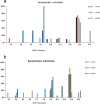Multidrug-resistant Salmonella Typhi among symptomatic and asymptomatic children in informal settlements in Nairobi, Kenya
- PMID: 39455953
- PMCID: PMC11515195
- DOI: 10.1186/s12879-024-10104-w
Multidrug-resistant Salmonella Typhi among symptomatic and asymptomatic children in informal settlements in Nairobi, Kenya
Abstract
Background: The emergence and persistence of multidrug-resistant (MDR) Salmonella Typhi (S. Typhi) infections is a significant global health problem. The carrier state of typhoid makes it prudent to conduct routine surveillance for both acute cases and carriers especially those caused by MDR S. Typhi. We report on the prevalence of MDR S. Typhi, resistance phenotypes and antimicrobial resistance genes detected in symptomatic and asymptomatic children living in informal settlements in Nairobi, Kenya.
Methods: 215 archived presumed S. Typhi isolates from stool samples provided by children ≤ 16 years collected from 2013 to 2018 were revived in May, 2022 and confirmed using culture and antisera serotyping. The Kirby Bauer disc diffusion technique was used to test the S. Typhi against 14 antibiotics. The MDR S. Typhi (resistant to ampicillin, chloramphenicol and sulfamethoxazole trimethoprim) which in addition were also resistant to either a cephalosporin or a fluoroquinolone were analyzed for Beta lactams and quinolone resistance genes using polymerase chain reaction.
Results: A total of 215 isolates were confirmed to be positively S. Typhi; of these, 105 (49%) and 110 (51%) were from symptomatic and asymptomatic children respectively. On average, S. Typhi resistance from asymptomatic and symptomatic children against 1st line drugs was observed at; 77% &70%, ampicillin; 60% & 64%, sulfamethoxazole-trimethoprim, and 45% & 54%, chloramphenicol respectively. Multi drug resistance was observed in 90 (42%) of the isolates, of these, 44 (49%) were isolated from symptomatic and 46 (51%) from asymptomatic children. Fifteen resistance phenotypes (p) were observed with, ampicillin/chloramphenicol/sulfamethoxazole-trimethoprim/nalidixic acid (amp/chl/sxt/na) as the most common among the symptomatic 43/90 (48%) and asymptomatic 55/90 (61%) children. The blaTEM-D, AMR genes were detected in 37/44 (84%) S. Typhi isolates, out of this 18 (49%) were from symptomatic while 19 (51%) were from asymptomatic children respectively.
Conclusion: The carriage of MDR S. Typhi among the asymptomatic children is concerning as they can act as potential transmitters of the typhoid disease to unsuspecting children. These study findings highlight the need for continued surveillance of antimicrobial resistance and mass immunization of children living in these urban informal areas.
Keywords: Salmonella Typhi; Asymptomatic; Informal settlements; Multi drug resistance; Phenotypes; Symptomatic.
© 2024. The Author(s).
Conflict of interest statement
The authors declare no competing interests.
Figures

References
-
- Centre for Disease Control. Typhoid and paratyphoid. Travellers Health. 2020;4:78.
-
- (WHO). (2017). Typhoid Fever. http://www.who.int/ith/vaccines/typhoidfever/en/
-
- (WHO). (2019). Vaccines and disease, Typhoid. Immunization, Vaccine and Biologicals Newsletter.
MeSH terms
Substances
Grants and funding
LinkOut - more resources
Full Text Sources
Medical

